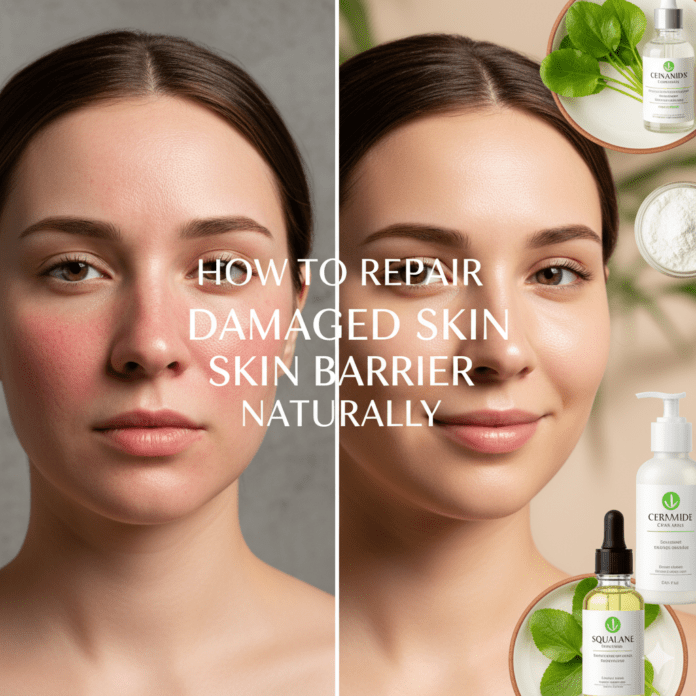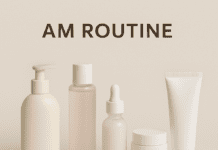Does your skin feel perpetually tight, irritated, and reactive? Does it sting when you apply even the gentlest products? Do you experience redness and flaky patches that just won’t go away? If you’re nodding along, you’re likely dealing with a compromised skin barrier.
Your skin barrier, or stratum corneum, is the outermost layer of your skin. Think of it as a diligent gatekeeper: it works to keep vital water and nutrients in, and harmful pollutants, bacteria, and irritants out. But when this barrier is damaged, it develops tiny, invisible cracks, leading to a host of frustrating skin issues.
While the temptation might be to throw more potent “fixing” products at the problem, the real solution is to do the opposite. The key is to strip back your routine and learn how to repair a damaged skin barrier naturally. This guide is your complete blueprint to soothe, heal, and strengthen your skin’s first line of defense.
Table of Contents
- First, Do You Have a Damaged Skin Barrier? Key Signs to Look For
- What Caused the Damage? Common Culprits of a Compromised Barrier
- The “Back to Basics” Skin Barrier Repair Routine
- Nature’s Pharmacy: 5 Key Ingredients to Heal Your Moisture Barrier
- Strengthening Your Skin Barrier from the Inside Out
- Frequently Asked Questions (FAQ) About Barrier Repair
1. First, Do You Have a Damaged Skin Barrier? Key Signs to Look For
Before you can start the healing process, you need to correctly diagnose the problem. A compromised barrier isn’t a specific skin type; it’s a condition that can happen to anyone.
Here are the most common signs of a damaged skin barrier:
- Increased Redness and Inflammation: Your skin looks consistently flushed or blotchy.
- Stinging or Burning Sensation: Even water or your most trusted products suddenly cause a stinging feeling.
- Chronic Dehydration and Tightness: Your skin feels tight and “stretched,” even after moisturizing. It lacks plumpness and may show more fine lines.
- Heightened Sensitivity: You’re suddenly reacting to products or ingredients that never bothered you before.
- Dryness and Flakiness: You have persistent dry, scaly, or flaky patches that creams don’t seem to fix.
- Increased Breakouts: A damaged barrier can’t effectively keep acne-causing bacteria out, sometimes leading to an increase in pimples or congestion.
If several of these sound familiar, it’s time to focus on repair.
2. What Caused the Damage? Common Culprits of a Compromised Barrier
Understanding the cause is crucial for preventing future damage. Most often, the barrier is weakened by a combination of factors:
- Over-Exfoliation: This is the #1 culprit in today’s skincare world. Overusing potent acids (AHAs/BHAs), retinoids, or harsh physical scrubs strips away the protective lipids of your skin barrier.
- Harsh Cleansers: Using cleansers with high levels of sulfates or a high pH can strip your skin of its natural oils, leaving it vulnerable and tight.
- Environmental Stressors: Extreme weather (cold, wind, low humidity), sun exposure, and pollution all take a toll on your skin’s defenses.
- Lack of Moisture: Not using a proper moisturizer allows for Transepidermal Water Loss (TEWL), where water evaporates from your skin, leading to dehydration.
- Stress and Lack of Sleep: The stress hormone cortisol can impair barrier function over time.
3. The “Back to Basics” Skin Barrier Repair Routine
When your barrier is compromised, your skincare routine needs to become a sanctuary of simplicity and nourishment. For the next 2-4 weeks, pause all potent actives—that means no exfoliants, no vitamin C, and no retinoids. Your new mantra is: Cleanse, Hydrate, Moisturize, Protect.
Step 1: Cleanse with a Gentle, pH-Balanced Cleanser
Ditch any foaming or stripping cleansers. Choose a creamy, milky, or gel-based cleanser that is sulfate-free and has a pH around 5.5 to respect your skin’s natural acidity. Cleanse only once in the morning (or just rinse with water) and once at night.
- Product Suggestions:
- La Roche-Posay Toleriane Hydrating Gentle Cleanser
- Krave Beauty Matcha Hemp Hydrating Cleanser
Step 2: Drench Skin in Soothing Hydration
While your skin is still damp, apply a hydrating toner or serum packed with humectants (ingredients that draw water into the skin) and calming agents. Look for glycerin, hyaluronic acid, panthenol, and centella asiatica.
Step 3: Seal with a Barrier-Supportive Moisturizer
This is the most critical step. Your moisturizer must do more than just hydrate; it needs to contain the ingredients necessary to rebuild your barrier. It should be your shield, morning and night. We’ll cover the specific ingredients to look for in the next section. This is the best moisturizer for barrier repair you can find.
Step 4: Protect with a Mineral Sunscreen (AM)
A damaged barrier is extremely vulnerable to UV damage. Sunscreen is non-negotiable. Mineral sunscreens (zinc oxide, titanium dioxide) are often better tolerated by sensitized skin than chemical sunscreens.
4. Nature’s Pharmacy: 5 Key Ingredients to Heal Your Moisture Barrier
Focusing on the right natural ingredients to repair your skin barrier is the core of this healing process. Look for these heroes on the ingredient lists of your products:
1. Ceramides: The Building Blocks
What they are: Ceramides are lipids (fats) that are naturally found in your skin, making up over 50% of its structure. They are the “mortar” that holds your skin cells (“bricks”) together. Why they work: When your barrier is damaged, you’ve lost ceramides. Replenishing them topically directly helps to patch up the cracks, retain moisture, and restore the barrier’s integrity.
- Look for:
Ceramide NP,Ceramide AP,Ceramide EOPon ingredient lists.
2. Niacinamide (Vitamin B3): The Multi-Tasking Soother
What it is: A form of Vitamin B3 that is a true skincare superstar. Why it works: Niacinamide is a powerful anti-inflammatory that reduces redness and irritation. Crucially, it also stimulates your skin’s own production of ceramides, helping your barrier to rebuild itself from within.
3. Fatty Acids & Natural Oils: The Nourishers
What they are: Essential fats that moisturize and maintain the skin’s structure. Why they work: Ingredients like linoleic acid, omega fatty acids, squalane, and jojoba oil mimic the natural lipids in your skin. They provide immediate comfort, reduce flakiness, and nourish the barrier without clogging pores.
- Look for: Squalane, Jojoba Oil, Shea Butter, Rosehip Oil.
4. Centella Asiatica (Cica): The Calming Miracle
What it is: A medicinal herb, also known as “Tiger Grass,” that has been used for centuries for wound healing. Why it works: Cica is rich in madecassoside, a compound that is exceptional at soothing inflammation, reducing redness, and promoting skin repair. It’s a lifeline for skin that stings and burns.
5. Panthenol (Provitamin B5): The Hydrating Healer
What it is: A humectant that converts to Vitamin B5 in the skin. Why it works: Panthenol is deeply hydrating and has incredible anti-inflammatory properties. It helps to speed up the skin’s healing processes, making it perfect for soothing over exfoliated skin.
5. Strengthening Your Skin Barrier from the Inside Out
Topical care is essential, but you can also support your skin’s healing through your diet and lifestyle.
- Eat Healthy Fats: Incorporate foods rich in omega-3 fatty acids, which help produce healthy skin lipids. Think salmon, walnuts, chia seeds, and avocados.
- Stay Hydrated: Drink plenty of water throughout the day to hydrate your skin from the inside.
- Manage Stress: Chronic stress raises cortisol levels, which can impair barrier function. Incorporate calming activities like meditation, yoga, or simple deep breathing exercises.
6. Frequently Asked Questions (FAQ) About Barrier Repair
Q1: How long does it take to fix a damaged skin barrier? Patience is essential. While you may feel some relief from tightness and irritation within a few days, it typically takes at least 2 to 4 weeks of consistent, gentle care for the barrier to significantly repair itself. For severe damage, it can take several months.
Q2: Should I stop using all my active ingredients? Yes. Immediately pause all exfoliants (AHAs, BHAs), retinoids, and high-concentration vitamin C serums. Reintroduce them one at a time, very slowly (e.g., once or twice a week), only after your barrier feels completely healthy and resilient again.
Q3: Is “slugging” with Vaseline or Aquaphor good for a damaged barrier? It can be very helpful for some, especially those with dry skin. Slugging involves applying a thin layer of an occlusive like petroleum jelly as the very last step of your nighttime routine. It creates an intense seal that prevents water loss and helps the skin heal. However, if you are very acne-prone, patch-test first.
Conclusion: Patience is Your Most Powerful Product
Repairing your damaged skin barrier naturally is a journey back to basics. By simplifying your routine, eliminating harsh products, and focusing intensely on ingredients that soothe, hydrate, and replenish, you give your skin the space it needs to heal itself.
Listen to your skin, treat it with kindness, and be patient. The result will be more than just relief from irritation—it will be a stronger, more resilient, and healthier complexion for the long term.







